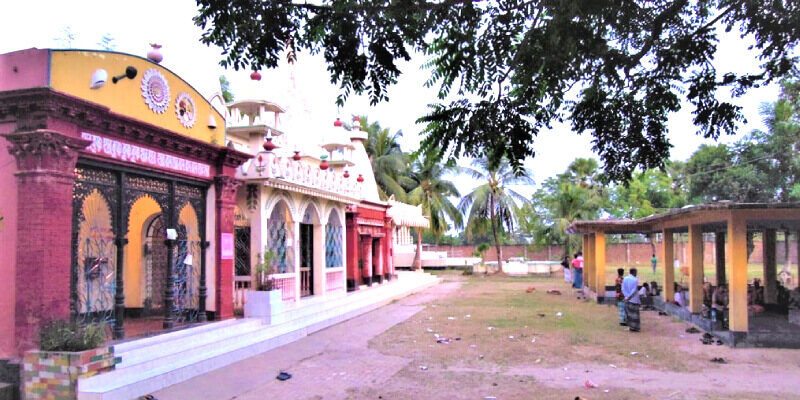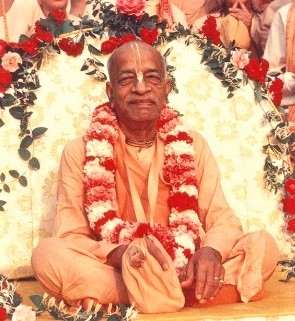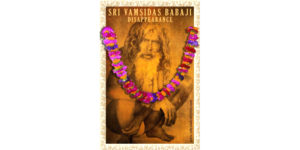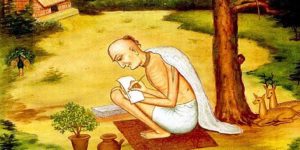akumära-brahmacäré sarva-tértha-darçi
parama-bhägavatottamaù çréla-narottama-däsa
“A brahmacäré for his entire life, Narottama däsa visited all the places of pilgrimage. He was on the highest platform of devotional achievement.” (Bhakti-ratnäkara 1.256)
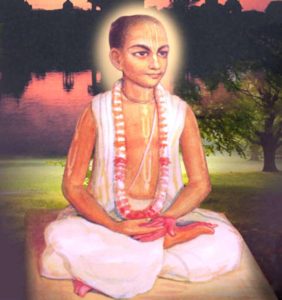
Narottama Dasa Thakura is Campaka Maïjaré in Kåñëa-lélä. Eternally assisting Rüpa Maïjaré in her service to Rädhä and Kåñëa, Campaka Maïjaré had mercy on the conditioned souls of this earth and appeared as Narottama in the village of Kheturi, about twelve miles from Rampur Bowaliya in the Gopalpur subdivision of Rajshahi District. This took place on the full moon day of the month of Magh, sometime around the middle of the 15th century of the Shaka era.
Narottama’s father was Räja Krishnänanda Datta, the zamindar of the Gopalpur area. His mother was Näräyaëi Devé. Räja Kåñëänanda had a younger brother named Puruñottama Datta, who had a son named Santoña.
From his early childhood, Narottama Dasa Thakura began to display symptoms of his future greatness. Everyone was amazed to see his great intelligence and his devotional demeanour. He was constantly absorbed in meditation on the wonderful qualities of Çré Caitanya Mahäprabhu and Nityänanda Prabhu. The Lord and His associates appeared to him in his dreams.
According to Prema-viläsa, when Mahaprabhu passed through Kanair Natashala, as He was dancing ecstatically in kértana He began to call out the name Narottama. When Nityänanda asked Him why He was calling out this name, Mahäprabhu answered, “My Lord, You do not know your own glories! When we went to Jagannätha Puré, you shed tears of divine love, day after day. I managed to capture your divine love and save it. Now I wish to keep it here by the Padmävaté River for Narottama däsa.”
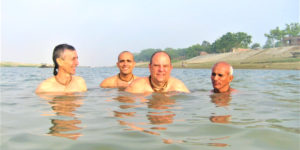
Mahäprabhu then went on to the Padmävaté River to the place known as Kutubpur, where He bathed and sang and danced in ecstasy. He then called out to the river, “O Padmävaté! Take my love and keep it here. When Narottama comes and bathes here, give it to him.”
The Padmävaté enquired, “How will I recognise him?”
Mahäprabhu answered, “You will know it is Narottama, for when he enters your waters, you will overflow.”
The place where Mahäprabhu placed prema for Narottama’s sake was later given the name Prematäli. When Narottama was twelve years old, he had a dream in which Nityänanda Prabhu told him to bathe in the Padmävaté and take the prema which had been stored there for him. He went the next day to the river and as soon as he put his foot in the water, the river started to overflow. The Padmävaté then remembered Mahäprabhu’s words and gave Narottama the prema which she had been safeguarding for him.
As soon as he experienced the ecstasies of prema, Narottama’s character, his appearance, everything about him changed. His parents noticed the transformation and did everything they could to bring him back to his normal state, but failed. Having drunk the wine of divine ecstasy, Narottama had become intoxicated, and the bonds of family life could no longer hold him back.
Narottama Dasa Thakura began to wonder how he could escape from his material entanglements. Finally one day, when his father and uncle were away on official business, he practiced some deception on his mother and tricked his bodyguards so that he could leave his family for Våndävana.
The Prema-viläsa also describes how Narottama took initiation from Lokanätha Gosvämé. Narottama was born on Maghi-pürëimä, his initiation took place on the Kärtika-pürëimä, and he was initiated by Lokanätha on the Shravan-pürëimä.
After the disappearance of Rüpa and Sanätana Gosvämés, Çré Jéva Gosvämé became the undisputed intellectual leader of all Gauòéya Vaiñëavas throughout Mathurä, Bengal, and Orissa, and the Chief Minister of the universal court of Vaiñëavas in Våndävana — the Viçva-vaiñëava-räja-sabhä. Çréniväsa, Narottama däsa, and Dukhé Kåñëa-däsa all studied the scriptures under Jéva, receiving detailed personal instruction from him. When their studies were completed, Jéva gave them the titles of Äcärya, Öhäkura, and Çyämänanda, respectively.
Jéva Gosvämé then sent his three students to Bengal with the Vaiñëava scriptures. Çré Jéva heard the news that the books had been stolen in Bana Viñëupura and then later that they had been recovered.
On Lokanätha Gosvämé’s orders, Narottama installed six sets of deities in his temple in Kheturi: Gauräìga, Ballabha-känta, Vrajamohana, Çré Kåñëa, Rädhä-känta, and Rädhä-ramaëa. The great festival which he held on that occasion is still remembered and honoured in the Vaiñëava world.
Prior to the Kheturi-mahotsava, Narottama Dasa Thakura travelled throughout Bengal and Orissa, visiting various places where Mahäprabhu had performed His pastimes, meeting the Lord’s associates, and receiving their blessings. Amongst the places he visited were Uddharan Datta’s home in Saptagram; Khardaha, where he met Parameçvaré Öhäkura, and Nityänanda’s çaktis, Jähnavä and Vasudhä; Khanakula Krishnanagara, the home of Abhiram Thakur; Çyämänanda’s home in Nrisinghapura; the Çrépatas of Narahari and Raghunandan in Çrékhanda; and the birthplace of Nityänanda Prabhu in Ekacakra-dhäma; Gopénätha Äcärya’s home, Haridasa Öhäkura’s samädhi, Gadädhara Paëòita’s place of worship, the Jagannätha Temple and Guëòicä, the Jagannätha-vallabha gardens, Narendra-sarovara, etc. in Jagannätha Puré.
Most of the living associates of Mahäprabhu and other leaders of the sampradaya came to Kheturi on the occasion of the festival organised by Narottama däsa. A list of these has been given by Narahari Chakravarti in his books, Bhakti-ratnakara and Narottama-viläsa: Çyämänanda Prabhu, Jähnavä Devé, Parameçvaré däsa, Kåñëa-däsa Sarkhela (Jähnavä’s uncle), Mädhava Acarya (Nityänanda’s son-in-law), Raghupati Vaidya, Minaketan Räma-däsa, Muräri Caitanya däsa, Jnana däsa, Mahidhara, Çré Çaìkarä, Kamalakara Pippalai, Gauräìga däsa, Nakarii, Kåñëa-däsa, Dämodara, Balaräma däsa, Çré Mukunda, Våndävana däsa Öhäkura, Raghunandana Öhäkura, and other devotees from Çrékandha; Çrépati and Çrénidhi (Çréväsa’s brothers) came from Navadvépa; Advaita’s sons, Acyutänanda, Gopal Miçra, and Kåñëa Miçra came from Shantipur; Hriday Caitanya and other devotees from Ambika Kalna, etc.
Çréniväsa Äcärya acted as the officiating priest at the festival and performed the rituals installing the deities. In the kértana led by Narottama which followed, Mahäprabhu and His associates themselves appeared.
After the Kheturi festival, Narottama’s fame spread throughout the Vaiñëava world. Prominent Brahmins like Ramakrishna Äcärya and Gaìgä-Näräyaëa Cakravarté became his disciples.
In Gopalpura village, there was a Brahmin named Vipra däsa. He had a poisonous snake living in his wicker grain-storage bin (gola). When Narottama visited Vipra däsa’s house, the snake vanished, and in its place appeared deities of Gaura and Viñëupriyä. Gaurasundara and His beloved Viñëupriyä came out of the gola and climbed into Narottama’s lap in plain view of everyone.

In the Gaudiya Vaiñëava Abhidhana, the following comments are found: “Narottama’s äçrama was in a place called Bhajanatuli, about two miles from his capital city, Kheturi. Narottama did his preaching through kértana. He created the style of kértana known as Garanahati. He wrote two books, Prärthanä and Prema-bhakti-candrika, which are like the very life of the sevotees. He has written songs which are appropriate for every devotional mood, and this is what touches the devotees’ hearts. These two books are so popular that they have been published countless times. Narottama’s influence can be appreciated even in distant Manipura.”
The deities installed by Narottama Dasa Thakura are no longer in Kheturi. There are some çälagräma çélas worshipped by Narottama Dasa Thakura in in Gauräìgabari Temple, and ISKCON has a temple nearby this temple. Every year a big festival is arranged in Kheturi Dhäma on the holy appearance day and disappearance day of Narottama däsa Öhäkura.
How to Go There
Kheturi is in Godagari, Rajshahi district. Buses are available from Rajshahi to Chapai Nawabganj. Get down at Basantapur stoppage. Take an auto-rickshaw to go to ISKCON temple. Gaurangabari temple is 2 km from there.
You can see other Holy Places. Click Here

